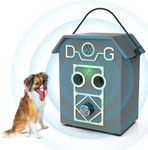Buying Guide for the Best Outdoor Anti Bark Device
Choosing the right outdoor anti-bark device can make a big difference in managing excessive barking while keeping your pet and neighbors happy. The key is to understand how these devices work and which features will best suit your environment and your dog's temperament. By focusing on the main specifications, you can find a device that is effective, safe, and easy to use.Detection RangeDetection range refers to how far away the device can sense barking and activate its deterrent. This is important because you want the device to cover the area where your dog spends most of its time. Short-range devices (up to 15 feet) are suitable for small yards or patios, while medium-range (15-50 feet) works for average-sized yards. Long-range devices (over 50 feet) are best for large open spaces or if you want to cover multiple areas. Choose a range that matches the size of your outdoor space and where your dog usually barks.
Correction MethodThe correction method is how the device discourages barking, most commonly using ultrasonic sound, but sometimes vibration or audible tones. Ultrasonic devices emit a high-pitched sound only dogs can hear, which is harmless but unpleasant. Some devices offer multiple correction methods or adjustable levels. If your dog is sensitive or easily startled, a gentle ultrasonic-only device may be best. For more stubborn barkers, a device with adjustable intensity or multiple methods can be more effective. Consider your dog's personality and sensitivity when choosing.
Weather ResistanceSince the device will be used outdoors, weather resistance is crucial. This means the device can withstand rain, sun, and temperature changes without malfunctioning. Devices are often rated as weatherproof or waterproof. Weatherproof means it can handle light rain and humidity, while waterproof means it can survive heavy rain or even being splashed. If you live in an area with harsh weather, look for a device with a high level of weather resistance to ensure it lasts longer and works reliably.
Power SourceOutdoor anti-bark devices can be powered by batteries, solar panels, or plugged into an outlet. Battery-powered devices are portable and easy to place anywhere, but you'll need to replace or recharge batteries regularly. Solar-powered devices are eco-friendly and require less maintenance, but they need to be placed in a sunny spot. Plug-in devices offer continuous power but need to be near an outlet. Think about where you want to place the device and how much maintenance you're willing to do when choosing the power source.
Sensitivity AdjustmentSensitivity adjustment lets you control how easily the device is triggered by barking. This is important to avoid false activations from other noises or distant dogs. Devices with multiple sensitivity levels allow you to fine-tune the response to your dog's barking habits and the noise level in your area. If you live in a quiet neighborhood, a lower sensitivity may be enough. In a noisy area, higher sensitivity might be needed. Choose a device with adjustable sensitivity for the most flexibility.
Mounting OptionsMounting options refer to how and where you can install the device. Some devices can be hung on a tree, mounted on a wall, or simply placed on a flat surface. The right mounting option depends on your yard layout and where your dog spends time. If you need to cover a specific area, look for a device with flexible mounting options so you can position it for the best coverage.









